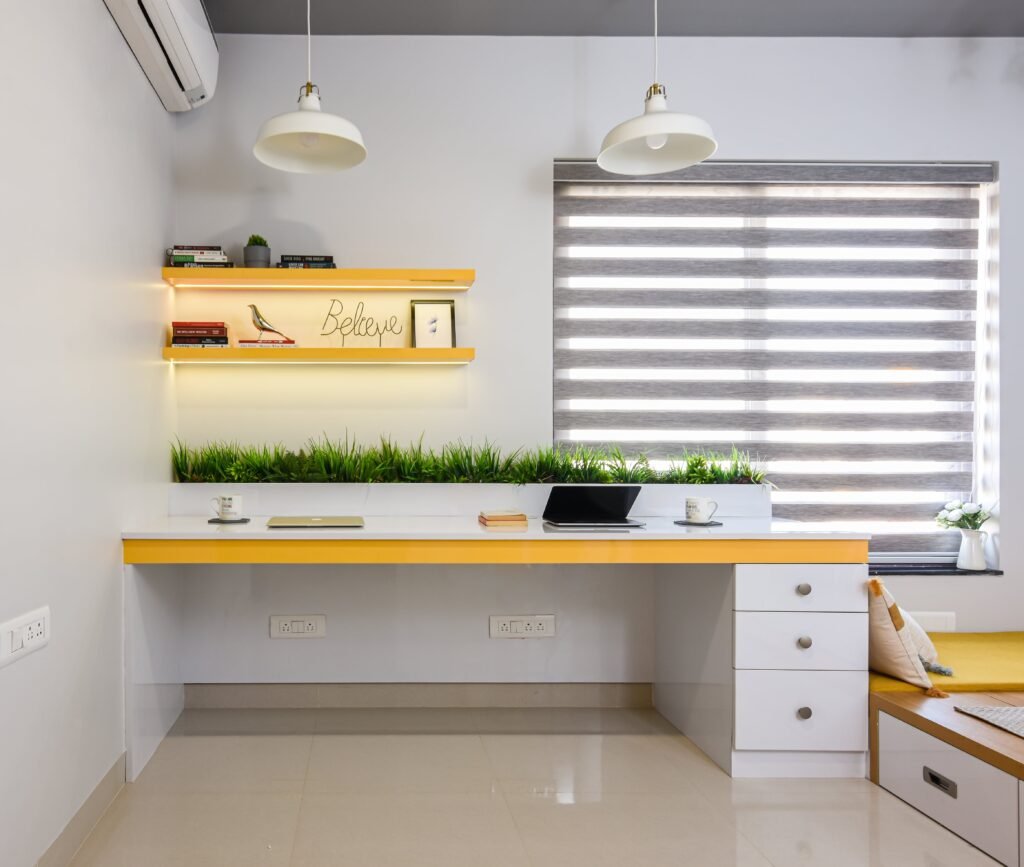Creating a personalized study room that perfectly fits your needs is an exciting project. Whether you’re setting up a dedicated space for work, study, or creative activities, a well-designed study room can significantly impact your productivity and comfort. In this guide, we’ll walk you through the process of study room design, from initial concept to the final creation, ensuring your space meets both functional and aesthetic goals.
Introduction
A study room is more than just a workspace—it’s a personal sanctuary for focused thinking, learning, and creativity. The right study room interior design can transform a cluttered or uninspiring area into a productive, calming, and stylish environment. Personalized study rooms should reflect your personality, support your workflow, and provide comfort to enhance concentration and efficiency.
In this article, we’ll explore how you can design your study room from scratch, focusing on layout, furniture, lighting, decor, and storage solutions that will make your space truly unique.
Defining Your Study Room Concept
The first step to creating your personalized study room is conceptualization. A clear vision will guide your design choices and ensure the space works for you.
1. Assess Your Needs
Before you begin, identify the primary functions your study room will serve. Ask yourself the following:
- Will this room be used primarily for studying, working, or both?
- Do you need storage for books, files, or other materials?
- How much space do you require for your activities (reading, writing, drawing, etc.)?
- Do you want a quiet retreat, or are you okay with a multifunctional space?
By answering these questions, you’ll have a clear understanding of what elements are essential for your study room interior design.
2. Choose a Style
Your study room design should reflect your personal style. Some popular styles to consider include:
- Minimalist: Clean lines, neutral colors, and a clutter-free environment.
- Contemporary: Modern furniture, bold accents, and functional decor.
- Traditional: Rich woods, classic furniture, and a warm atmosphere.
- Industrial: Exposed materials like brick and metal with simple, sturdy furniture.
- Scandinavian: Light colors, natural elements, and functional design.
Deciding on a style will influence your choice of furniture, colors, and decor, allowing you to create a cohesive and aesthetically pleasing space.
Layout and Space Planning
Once you’ve conceptualized your study room, it’s time to plan the layout. Effective space planning is crucial for creating a comfortable and organized study room interior design.
1. Optimal Furniture Placement
Consider the following when arranging your furniture:
- Place your desk near a window to maximize natural light.
- Keep bookshelves or storage units easily accessible without crowding the space.
- Allow enough room for comfortable movement around the desk and other furniture.
2. Zoning Your Study Space
You may want to create different zones within your study room for various activities. For instance:
- Work Zone: This should include your desk, chair, and any necessary tech equipment.
- Reading Zone: Set up a comfortable chair or lounge area for relaxed reading.
- Storage Zone: Install shelves, cabinets, or drawers to keep your study room organized and clutter-free.
Furniture Selection
Choosing the right furniture is key to creating a functional and comfortable study room. The main pieces you’ll need include:
1. Desk
- Choose a desk that fits your needs—whether it’s a large surface for spreading out papers or a compact desk for a laptop.
- Consider desks with built-in storage to keep essentials within reach.
2. Chair
- Invest in an ergonomic chair to support proper posture during long hours of work or study.
- Ensure the chair height is adjustable and fits comfortably with your desk.
3. Shelving and Storage
- Install bookshelves or floating shelves to display books, files, and decor.
- Use drawers or cabinets for storing items you don’t use every day but still need on hand.
Lighting: A Key Element
Lighting plays a significant role in study room design as it affects both functionality and mood.
1. Natural Light
- Position your desk near a window to benefit from natural light, which reduces eye strain and creates a more inviting atmosphere.
- Use light-filtering blinds or curtains to control the intensity of sunlight during different times of day.
2. Task Lighting
- A good desk lamp is essential for focused tasks like reading, writing, or working on the computer.
- Opt for adjustable lamps with focused lighting to illuminate specific areas without causing glare.
3. Ambient Lighting
- Overhead lighting, such as pendant lights or recessed lighting, can provide general illumination for the entire room.
- For a cozy ambiance, consider adding floor or wall lamps with warm bulbs.
Personalizing Your Study Room Decor
Personalizing your study room with decor that reflects your taste and personality will make the space feel more inviting and inspiring.
1. Wall Art and Inspiration Boards
- Hang artwork, posters, or framed quotes that motivate and inspire you.
- Use corkboards or magnetic boards to pin important notes, reminders, or inspirational images.
2. Color Scheme
- Choose a color palette that promotes focus and calm. Light, neutral shades like white, beige, or soft blue work well for study rooms.
- Accent walls or pops of color can add visual interest without overwhelming the space.
3. Plants and Greenery
- Incorporating plants into your study room design can improve air quality and create a relaxing environment.
- Small potted plants or succulents are ideal for desks, while larger floor plants can fill unused corners.
Storage Solutions
Keeping your study room organized is crucial for maintaining focus and efficiency.
1. Shelves and Cabinets
- Wall-mounted shelves are perfect for storing books, files, or decorative items without taking up floor space.
- Closed cabinets or drawers can hide clutter and keep the room looking tidy.
2. Desk Organizers
- Use drawer dividers, pencil holders, and trays to organize office supplies and keep your desk surface clear.
3. Multi-functional Furniture
- Opt for furniture that doubles as storage, such as ottomans with hidden compartments or desks with built-in shelves.
Final Touches: Bringing It All Together
Once the furniture, layout, and decor are in place, it’s time to add the finishing touches to make the space your own.
1. Technology Setup
- Ensure that your study room has all the necessary tech equipment, including a reliable computer, printer, and Wi-Fi access.
- Hide cords and cables using cable management solutions for a clean and organized look.
2. Personal Mementos
- Include personal items like photos, souvenirs, or awards to make the room feel truly yours.
- These little touches can provide motivation and remind you of your goals while you work or study.
Conclusion
Designing a personalized study room from concept to creation involves careful planning, attention to detail, and a balance of functionality and aesthetics. By assessing your needs, choosing a style, planning the layout, and selecting the right furniture and decor, you can create a space that not only boosts productivity but also reflects your personality. A well-designed study room provides the perfect environment for focused work, learning, and creativity.
Whether you prefer a minimalist or traditional look, incorporating personal touches and maintaining a clutter-free space will make your study room an inspiring place to be.




